India@76: 77% citizens surveyed confident that India’s clout in the world will grow further by the time it turns 80; Many believe corruption, social stability and women and child safety likely to be a concern even then
- ● 55% citizens believe India will be able to deliver growth and prosperity for most by 2027
- ● 77% citizens believe India will be able to create lots of small entrepreneurs but limited jobs
- ● 40% citizens surveyed listed “creating enough employment and livelihood opportunities” will be top challenge for India in the next 4 years; 18% believe it will be delivering economic growth
- ● LocalCircles India@76 survey receives over 92,000 responses from citizens in 379 districts of India
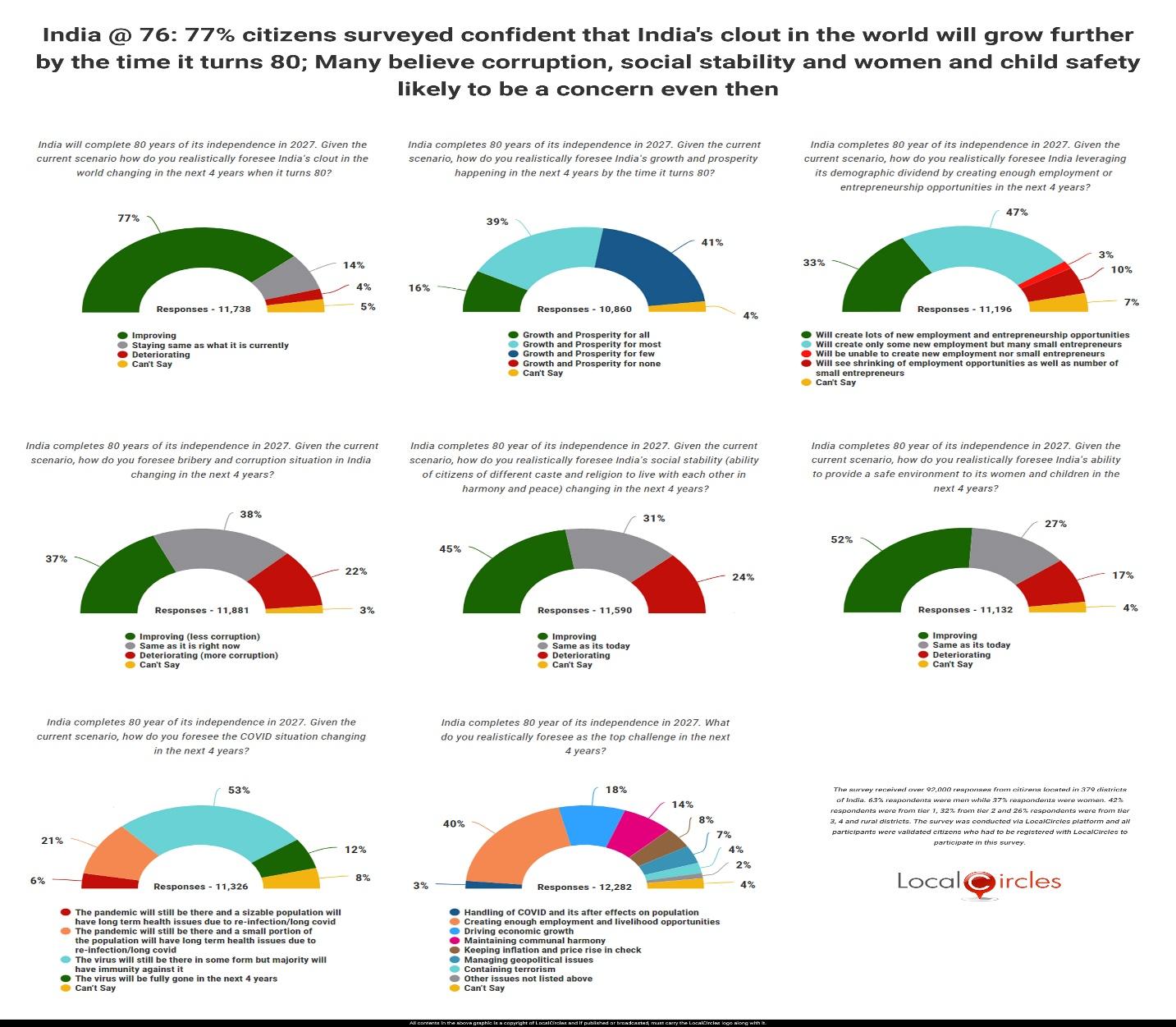
August 15, 2023, New Delhi: India is expected to overtake China as the most populous country by 2027 when it celebrates 80 years of Independence. At this landmark juncture, global economists are optimistic that a lot of factors will help India to emerge as the third biggest economy in the world, from its fifth position currently.
A shift in policy approach towards boosting investment, demographics advantages and the public digital infrastructure will make India the world's third-largest economy by 2027, Morgan Stanley has forecast. “India will more than double its gross domestic product (GDP) from the current $3.4 trillion to $8.5 trillion over the next 10 years, Morgan Stanley's chief Asia economist Chetan Ahya wrote in Financial Times. "Incrementally, India will add more than $400 billion to its GDP every year, a scale that is only surpassed by the US and China," Ahya wrote in Financial Times in November 2022."The shift in India's policy approach is moving it closer to the East Asian model of leveraging exports, raising savings, and recycling it for investment."Ahya noted that India's GDP today is where China's was in 2007 - a 15-year gap.
But the demographic dividend will work to India’s advantage as the median age today is 11 years younger than China's. Productivity growth differentials also favour India. India is on the cusp of returning to a high growth trajectory, said eminent economist Arvind Panagariya, early this year in February. “My sense is that given where India stands currently, it should get back to 7% plus kind of growth rate," Panagariya said, adding that India is currently in a spot it was in 2003 when the growth rate picked up to nearly 8% and the country sustained that kind of growth rate for a few years. NITI Aayog CEO BVR Subrahmanyam is reported to be optimistic that with India’s infrastructure work having made much progress, it is at a juncture to really take off. Digital India program and young population will be very helpful in becoming the third largest economy. According to a Bloomberg's report, there is a possibility of recession in all the developed countries of the world including China, but India will remain untouched by it.
HSBC India Chief Economist Pranjal Bhandari recently expressed optimism that the Indian economy has the potential to grow at 6.5% for the next ten years. However, if digitization of sectors like agriculture and MSMEs takes place, the growth rate can go up to 7.5% and help the Indian economy become the third largest economy by 2027. An average growth rate of 7% will help the Indian economy to touch the level of $ 7.5 trillion from the current $3.5 trillion (reached in 2022). India is among several G20 economies, including the U.S., China, Russia and the EU region, whose 2023 growth projections were raised by Moody’s in an update to its global macroeconomic outlook on February 28. Global rating major Moody’s in its report said India's growth is primarily driven by a young and educated workforce, rapid urbanisation, government spending on infrastructure, commitment to net zero carbon emissions and rising private consumption. According to economic experts, the Indian economy is also getting a lot of boost from the tremendous growth in service exports, pharma, electronics along with digital infrastructure.
Even as both Indian and global economists are projecting a return to high growth of 7% or even more in the coming years, LocalCircles has sought to find out through a mega national survey whether citizens share the same optimistic growth and whether consumer sentiments have improved since last year when India celebrated 75 years of Independence. The survey received over 92,000 responses from citizens located in 379 districts of India. 63% respondents were men while 37% respondents were women. 42% respondents were from tier 1, 32% from tier 2 and 26% respondents were from tier 3, 4 and rural districts.
77% of citizens are optimistic of India’s clout in the world improving in the next 4 years, 14% believe it will remain the same
After three years of grappling with COVID pandemic and its impact on all spheres of life in India and globally, many citizens are looking forward to better prospects in terms of employment, business, and improved lifestyle. The survey first sought to know from citizens what is their vision or optimism about India’s standing in the global arena. It asked them, “India will complete 80 years of its independence in 2027. Given the current scenario, how do you realistically foresee India’s clout in the world changing in the next 4 years when it turns 80?” Out of 11,738 respondents to this query 77% expressed optimism of India’s standing in the global arena “improving”; 14% felt it will remain the “same as what it is currently”. There are however 4% of respondents who foresee it “deteriorating” and 5% opted for a cautious “can’t say”. In sum, while 77% of citizens are optimistic of India’s clout in the world improving in the next 4 years, 14% believe it will remain the same.
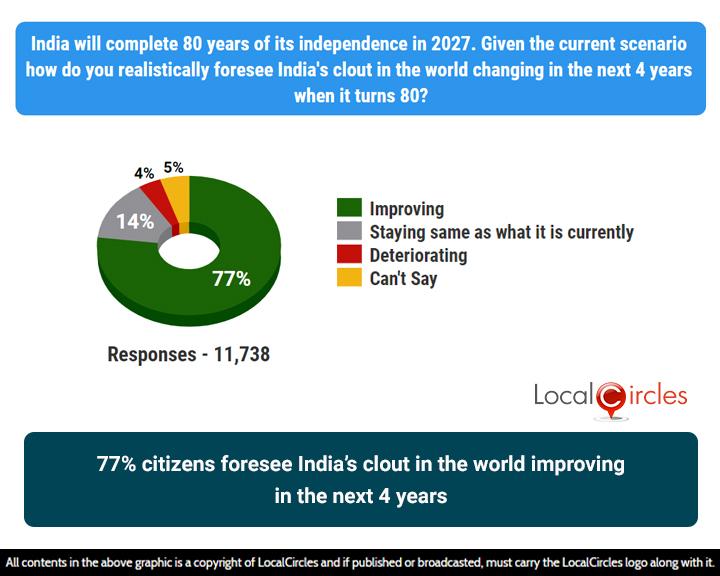
55% of citizens’ surveyed expressed optimism that there will be growth and prosperity for most people by 2027
An issue that has been often aired in India and across the world is whether high economic growth spells prosperity and wellbeing for all with more people crossing the BPL to middle class or does it mean that the rich become richer and the poor get pushed down further in poverty. The survey sought to know as “India completes 80 years of its independence in 2027, given the current scenario, how do you realistically foresee India’s growth and prosperity happening in the next 4 years by the time it turns 80?” This query received 10,860 responses with 55% of citizens’ surveyed expressing optimism that there will be growth and prosperity for most people by 2027. The data shows that while 16% are optimistic of growth and prosperity for all; 39% feel the next 4 years will bring growth and prosperity for most; however 41% of citizens surveyed feel that India’s growth and prosperity will benefit only few while 4% of respondents are still uncertain and stated “can’t say”.
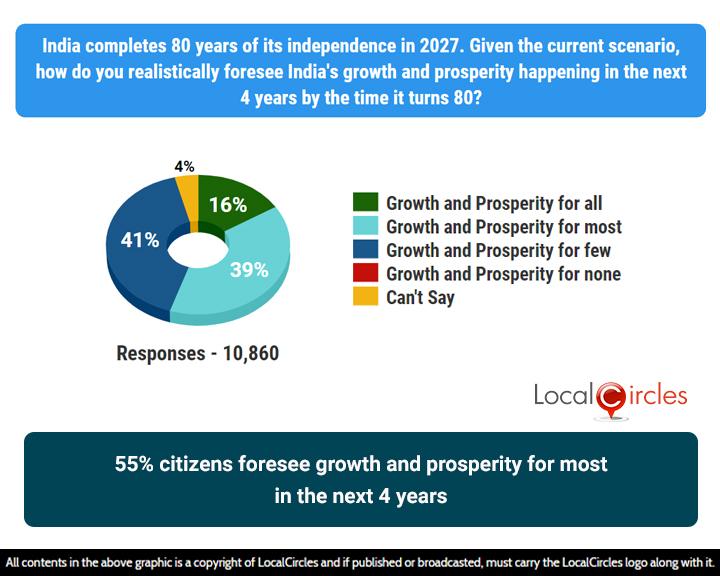
Oxfam India’s “Survival of the Richest: The India Supplement" report released early this year reveals that in 2022, the gap between the rich and the poor indeed widened with just 5% of Indians owning more than 60% of the country’s wealth while the bottom 50% of India’s population possessed only 3% of wealth. Even though there are expectations that India’s GDP growth may return to 7% in the next few years, it is not certain that everyone will benefit given the high inflation and poor healthcare system such that one serious illness can wipe out family savings.
Only 1 in 3 expressed optimism of India being able to create enough job or entrepreneurship opportunities in the next 4 years
The survey then asked the same question to residents of Karnataka. It asked, “How many individuals do you have in your household who currently have one or more COVID/ flu/ viral fever symptoms like fever, runny nose, sore throat, cough, headache, joint pain, body ache, respiratory issues, etc.?” This query received 3,519 responses from Karnataka residents with 11% indicating that 4 or more individuals in their household were unwell while 22% indicated 2-3 members in their household were unwell with COVID/ viral symptoms while the remaining 67% of respondents were happy that “no one” in their household was unwell. In sum, 33% households surveyed in Karnataka now have one or more individuals unwell.

52% of citizens surveyed feel the scenario with regards to women and child safety will improve going forward
As globally and in India people had to bear the impact directly or indirectly of many unexpected situations like the COVID led pandemic, impact of Russia and Ukraine war, climate change – all have left their impact some more lingering than expected. During the pandemic more women than men lost their jobs. While many companies are making efforts to employ more women, including allowing them to work from home on most days, there is still much gender bias against women. This bias against girl child and women still persists in many families whether it is in giving them opportunities or power to make decisions. For instance, at the national level while male literacy stands at 84.70%, female literacy is 70.30%. Similarly, crimes against women and children whether at home, workplace, schools (both girls and boys) or outside continue unabated and often gets unreported. Even in parliament they are under-represented. The survey next sought to know from citizens “Given the current scenario, how do you realistically foresee India’s ability to provide a safe environment to its women and children in the next 4 years?” This query received 11,132 responses with 52% of citizens’ surveyed expressing optimism that India will be able to improve safety of women and children in the next 4 years when it celebrates 80 years of independence. The data shows that while 52% feel the scenario with regards women and child safety will improve going forward; 27% feel it will remain the same as it is today; 17% however fear that it will deteriorate and 4% are uncertain on the issue so opted for “can’t say”.

37% of citizens surveyed are hopeful that corruption and bribery situation will improve in the next 4 years
India’s fight against corruption whether through demonetization or shift to digital transactions or contactless government service don’t appear to be yielding desired outcomes on the corruption front as yet, as many studies have reported. With most of black money getting converted into new currency notes post the 2016 demonetisation, bribery and corruption on the ground continues unabated. It is only in select cases that the human interface replaced by a systems interface has been able to get rid of the bribery and corruption that prevailed. In case of applying for a new passport or its renewal, while bribery for the most part has been eliminated from the passport seva kendra processes, the last mile of police verification is still ridden with it. The LocalCircles survey sought to know from citizens “given the current scenario, how do you foresee bribery and corruption situation in India changing in the next 4 years?” This query received responses from 11,881 citizens with only 37% expressing optimism of the situation “improving (less corruption); 38% don’t foresee things improving instead expect the situation to be “same as it is right now”; 22% in fact expect the situation to “deteriorate (more corruption)”; and 3% of respondent stated “can’t say”.
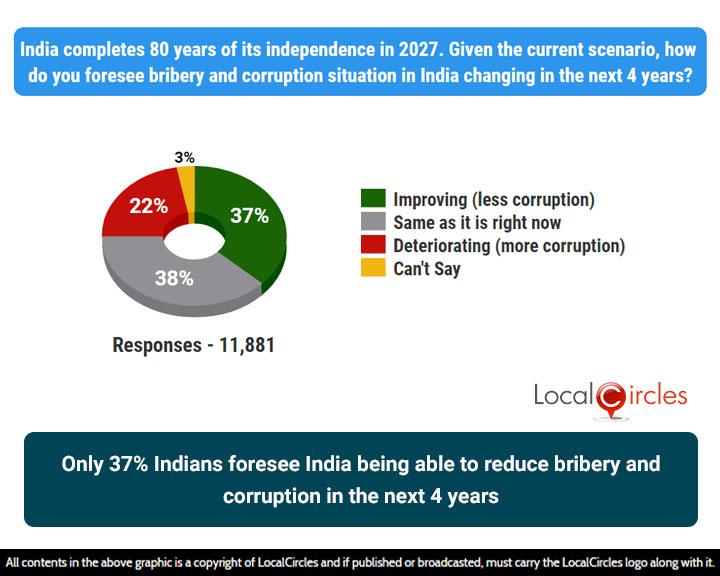
Only 45% of citizens surveyed foresee the social stability in the country “improving” in the next 4 years
Caste, religion and communal tension may make headlines but for the common man all these spell unease, evoking fears of political strife and communal riots whether in Manipur, Gurugram or any other part of the country. Just within the last few months, extensive communal riots in Manipur between the Maitei and Kuki communities including crimes against women have put us to shame as a society. Similar was the case with Gurugram, the so called tech hub of India where clashes between Hindus and Muslim community again were something that should have not happened in the first place. In both these cases, the administration failed to be proactive, thereby leading to the situation deteriorating further.
The survey sought to know the outlook of citizens on social stability. It asked them, “Given the current scenario, how do you realistically foresee India’s social stability (ability of citizens of different caste and religion to live with each other in harmony and peace) changing in the next 4 years?” The response to this query from 11,590 citizens was not very optimistic as only 45% foresee the social stability “improving” in the next 4 years; 31% of citizens surveyed expect it to remain “same as its today”; and 24% expect the situation to be “deteriorating”. Not the best of scenarios with the parliamentary elections due in 2024.

53% of Indians surveyed said that they believe COVID will still be there 4 years from now but majority will have immunity against it
Focusing on the continuing impact of COVID and its variants as many reports bear out that there are lingering health conditions manifesting or aggravating diseases that were prevalent at the time they got the virus, in some cases more than once. With new variants emerging, re-infection of Covid being a major risk and the risk of long Covid, the survey asked respondents, “Given the current scenario how do you foresee the COVID situation changing in the next 4 years?” This query received 11,326 responses with 53% of Indians surveyed indicating that they believe COVID will still be there 4 years from now but majority will have immunity against it. The data shows that apart from 53% who believe that the “virus will still be there in some form but majority will have immunity against it”; 21% believe the “pandemic will still be there and a small portion of the population will have long term health issues due to re-infection/ Long COVID”; and 6% of the population felt the “pandemic will still be there and a sizeable population will have long term health issues due to re-infection/ Long COVID. In addition, 8% of the respondents opted for “can’t say”. The responses show the majority fear long term health issues due to the pandemic and while 53% are confident of people developing immunity against it, 4 in 10 are not so confident and fear long term impact on health.
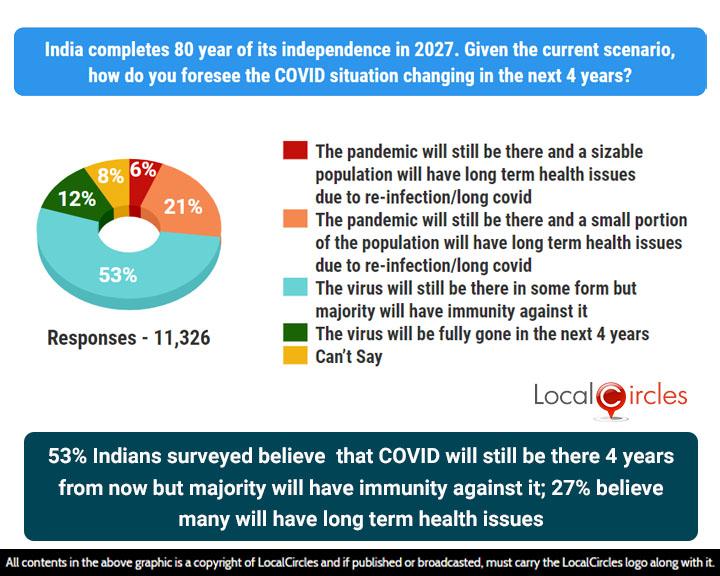
40% citizens surveyed indicated that “creating enough employment and livelihood opportunities” will be India’s top challenge in the next 4 years
India is striving to ensure higher economic growth by pushing ahead with investments in infrastructure projects, making agriculture more rewarding in terms of yield and farmers income, enabling the country to become a manufacturing hub, reducing reliance on imports but also raising its share in the global trade. All these development plans and their timely execution are essential not only for domestic consumers but also to help India emerge as an important player on the international scene. For instance, India is one of the largest grower and exporter of rice. The recent government decision to ban export of white non-basmati rice has seen a rise in the international price of the commodity. Similarly, India remains import dependent for its fossil fuel needs. Any rise in the price of crude oil and gas, as witnessed in the wake of the Russia and Ukraine war, impacts the economy and also the average citizen. The survey asked the citizens “what do you realistically foresee as the top challenge in the next 4 years?” This query received 12,282 responses with 40% indicating that “creating enough employment and livelihood opportunities” will be India’s top challenge in the next 4 years. Of the remaining, 18% indicated “driving economic growth”; 14% indicated “maintaining communal harmony”; 8% indicated “keeping inflation and price rise in check”; 7% feel “managing geopolitical issues” would be a challenge; 4% feel “containing terrorism” remains a challenge; 3% remain apprehensive about “handling of COVID and its after effects on population”; 2% indicated “other issues not listed above”. In addition, 4% opted for “can’t say”.
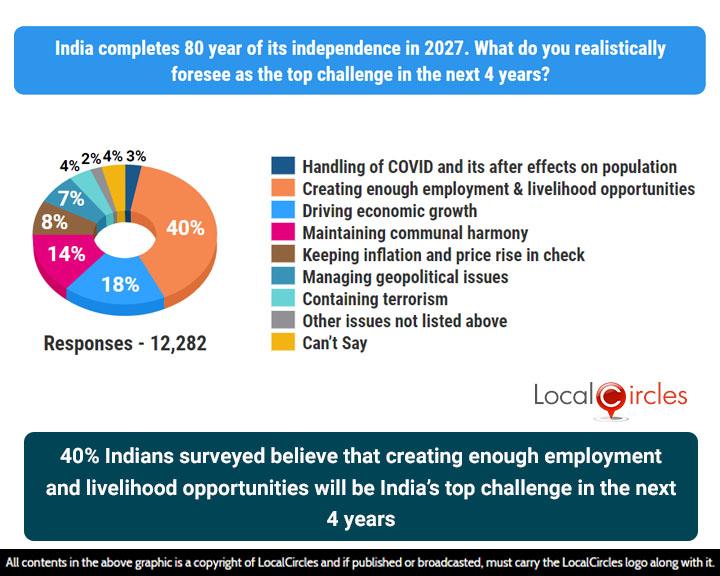
In summary, the survey brings forth the optimism and apprehension of citizens on various fronts about the four years ahead as India will mark 80 years of Independence in 2027. With 55% citizens of the opinion that most Indians will experience growth and prosperity in the next 4 years is another positive. People of the country are not so optimistic about job creation in the next 4 years but 77% are optimistic that we will be able to create many small entrepreneurs. However, on the social front, people do not seem to be as rosy in their outlook. Only 52% believe that India will be able to improve the women and child safety situation and only 37% believe bribery and corruption will reduce in the next 4 years. Similarly, only 45% citizens see India’s social stability improving by the time we turn 80. Social stability being the ability of people of different castes and religion to live with each other. These three areas of social stability, corruption and women and child safety are the ones India’s central and state leaderships needs to focus upon. At an overall level, the survey found that most people believe the biggest challenge for the country is clearly creating enough employment and livelihood opportunities with 40% vote followed by 18% who voted for creation of economic growth which indicates that 58% believe that India’s top challenge will be enabling this growth and prosperity for the most. However, as the Government works on this growth and prosperity it must not lose sight of the social challenges of corruption, women and child safety and social stability and work towards beating people’s expectations on this front. Only then, India’s growth and prosperity will be sustainable and it can aspire to become a developed nation in the next three decades.
Survey Demographics
The survey received over 80,000 responses from citizens located in 376 districts of India. 63% respondents were men while 37% respondents were women. 41% respondents were from tier 1, 32% from tier 2 and 27% respondents were from tier 3, 4 and rural districts. The survey was conducted via LocalCircles platform and all participants were validated citizens who had to be registered with LocalCircles to participate in this survey.
About LocalCircles
LocalCircles, India’s leading Community Social Media platform enables citizens and small businesses to escalate issues for policy and enforcement interventions and enables Government to make policies that are citizen and small business centric. LocalCircles is also India’s # 1 pollster on issues of governance, public and consumer interest. More about LocalCircles can be found on https://www.localcircles.com
For more queries - media@localcircles.com, +91-8585909866
All content in this report is a copyright of LocalCircles. Any reproduction or redistribution of the graphics or the data therein requires the LocalCircles logo to be carried along with it. In case any violation is observed LocalCircles reserves the right to take legal action.
Enter your email & mobile number and we will send you the instructions.
Note - The email can sometime gets delivered to the spam folder, so the instruction will be send to your mobile as well


